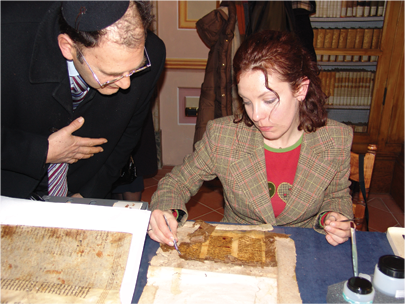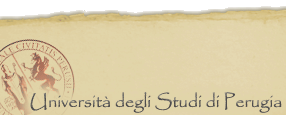 |
||||||||
The Fragments of Hebrew Manuscripts discovered in the binding of books
>> Download Brochure <<
|
||||||||
|
With the recent discovery of Hebrew parchments removed from mediaeval codices and reused to cover printed books, Perugia is added to the list of centres where the phenomenon described as the "Italian Genizah" is documented, by analogy with a true Genizah, or store room where Jews since time immemorial placed sacred texts in order to avoid desecration. Today thanks to the discoveries made by Dr Gianfranco Cialini, we may now speak of the "Perugia Genizah".
It is already more than twenty-five years since the late Giuseppe Baruch Sermoneta in 1981 launched the Hebrew Fragments in Italy Project or the Italian "Genizah" Project. By a happy intuition he anticipated the systematic survey of re-used Hebrew manuscripts which was later coordinated with other projects concerned with non-Hebrew manuscripts discovered in Italy. The survey of the disiecta membra of Hebrew codices is not yet complete, but has so far brought to light around 10,000 fragments of Hebrew manuscript books, for the most part whole pages or double pages as well as smaller fragments. Discovering these remains means giving new life, so to speak, to manuscripts that had been "dead" for four or five centuries. It involves entering into the history of the Hebrew manuscript book, following its journeys, and examining the methods and forms of its conservation, as well as its ritual destruction by the Jews in what may be described at its "death" and "burial" in a Genizah, or its destruction in the fires lit by the Church in the sad history of 2000 years of persecution - or in this case in its recycling. There are currently a little more than 70,000 Hebrew manuscript books preserved in around six hundred national, state, public, municipal, university and monastic libraries, as well as in private collections. In addition about 150,000 fragments of mediaeval manuscripts were recovered from the Cairo Genizah in the Ben Ezra Synagogue in Old Cairo. But between the Qumran manuscripts, first discovered in 1947 and dating from the 2nd century BCE to the 1st century CE, and the most ancient mediaeval manuscript we possess, there is an almost total void of about eight hundred years. From the ninth century to the middle of the sixteenth, only about 5% of all the manuscripts produced by the Jews in the Middle Ages have survived. So the discovery of a single page or even a fragment of a new mediaeval Hebrew manuscript is of enormous significance.
We must not automatically assume that the manuscripts found in the archives and libraries of a city were necessarily the possession of the Jews of that city, although this cannot be excluded. It was commercial factors that determined the movement of parchment books for reuse which were sold by second hand dealers over distances of hundreds of kilometers, thereby often leaving in a binder's store in one region, parts of books bought for reuse in another.
In Perugia twenty-four printed volumes have recently been identified which have their binding boards reinforced by double pages of Hebrew manuscripts of large format, reused for this humble purpose. But we must be grateful to this precious reuse insofar as these disiecta membra of books have not all been lost, like thousands of pages and double pages which made up the rest of the manuscripts from which the parchments reused for binding were removed. Of the twenty-four printed books in question, twenty were rebound with complete double folios, and four detached from two single folios. The forty fragments, mainly double folios, come from six different manuscripts: 1. Six double folios from a beautiful Hebrew Bible, copied between the end of the thirteenth century and the beginning of the fourteenth in a German region, containing parts of the biblical book of Jeremiah, with the Aramaic version or Targum intercalated in every Hebrew verse. 2. Four folios from a work copied in an Ashkenazi region in the XIV-XV centuries. It is a legal handbook by the Talmudist Mordekai ben Hillel (Germany c.1240-98) who wrote this compendium of Jewish religious law in the stryle of the Tosaphists, or glossators of the Commentyary on the Talmus by Rashi (Shelomoh ben Yitzhaq). In it the author records, on various comòlicated legal questions, the opinion of the masters of the Franco-German Talmudic school, many of which are preserved only in this work. Composed before 1286, Sefer Mordekai has the same structure as that used by Alfasi, following the order of the tractates of the Talmud. 3. Two double folios of medium dimensions from the binding of one printed text, which come from a manuscript copied in Italy in the XIV century, containing part of Maimonides' Mishneh Torah ("Repetition of the Torah"), a large-scale legal compendium written by the greatest Jewish philosopher, physician and thinker of the Middle Ages 4. Twenty folios from a single manuscript containing an important compendium of Jewish religious law, reused in the binding of ten printed volumes, and containing parts of the work of Moshe ben Ya'aqov of Coucy, entitled Sefer Mitzvot Gadol or "The Great Book of Commandments" 5. Four folios reused in the binding of two printed volumes, containing part of the legal compendium Sefer ha-Terumah, composed by Baruk ben Isaac of Worms. This copy was done in a Franco-German area between the XIV and XV centuries 6. Finally, last but certainly not in importance, are eight fragments, mainly single folios, removed from an interesting manuscript containing the Babylonian Talmud, copied in Spain in XIII century, and then, by some sequence of events of which we have no details, brought to central Italy, used as a sacred text, and then finally reused in the binding of four volumes which ended up in the Biblioteca del Dottorato. The fragments from the Talmud are of particular importance both for their antiquity and because of the fact that this work was the Hebrew book most systematically disputed, confiscated and burnt by the Catholic Church and its Inquisition to the point where only one complete manuscript exists, preserved in Munich and copied in the XV century, alongside a few other incomplete manuscripts.
As a footnote we might mention the discovery in the 1980s in the State Archive of Perugia of a fragment removed from a biblical codex of significant antiquity, copied between the XII and XIII centuries and reused in the binding of a printed book. It contains part of the book of Ezekiel cap.48 vv.15-23 and vv.26-34 |






